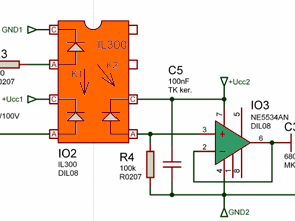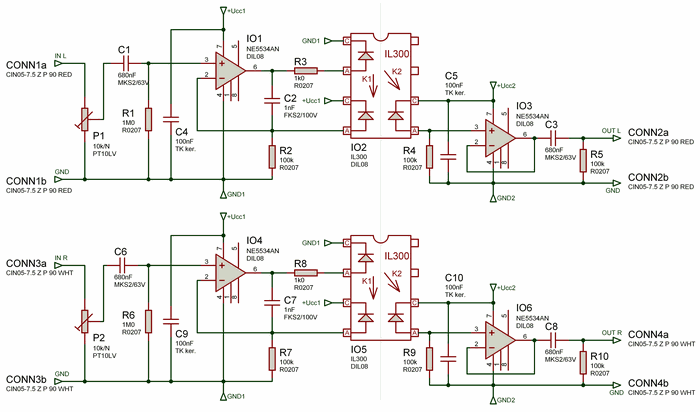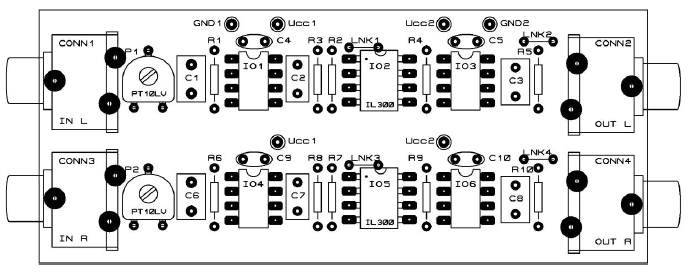
Linear optocoupler IL300 One of the diode is part of the output circuit, the other is used as feedback. IL300 optocoupler is suitable for both direct and transfer AC signal with a bandwidth of 200 kHz via a linearity of up to 0.01%. The function is stable in terms of temperature, while the temperature coefficient is only ± 0.05% / oC. The effective value of the insulation voltage, which lasts at IL300 trial period is 1s 5300V. Transmitter, the input side is emitting diode AlGaAs. Operating current can be between 0.5 mA to 40 mA, the best linearity is at 5 mA. On receiving feedback side of the silicon photodiode operating at a radiation source current. optical transmission occurs at a wavelength of 890nm.
These optocouplers, which are referred to as linear, are designed so as to have an input light emitting diode whose radiation is branched and is incident not only to one, as is the case with standard optocouplers, but the two photodiodes, which allows to achieve appropriate involvement of high linearity of transmitting audio signals.
Audio Signal Optical Separator Schematic

Circuit optical signal separator NF led me fact, the constant hum penetrating into the audio signal. This situation arose especially if you try to connect your computer to other audio equipment. intoxicate grounding of some parties of the transmission chain is gambling with their own lives. therefore I focused on as simple as possible circuit arrangement of “separators” ground potential with quality transmission parameters and minimal distortion. This design addresses unidirectional fiber separation in a direction away from PC to the amplifier, if we wanted a two-way transmission, for example, to record audio to PC, we use a pair of these separators NF signal. With the involvement of we must not forget the inverted potentials (input-output).

When the interconnection of low-frequency devices sometimes appear problems with different potentials (ground loops). Especially when the devices and devices connected to different countries (potentials) can do audio signal to penetrate unwanted noise and hum. Professional solution is balanced line audio signal, which significantly reduces interference signals. more better separation, sometimes galvanic ensures line transformer designed for low frequency applications. Quality transformers are however quite expensive and require also good shielding. The alternative at the request of galvanic isolation, the use of linear optocoupler as in this design. If the digital signal is very simple solution is to use the optocoupler.
Low-Frequency Audio Signal Separator PCB schematic files download:
FILE DOWNLOAD LINK LIST (in TXT format): LINKS-25332.zip
Published: 2014/03/06 Tags: analog circuits projects, audio control circuits
Stereo Tone Controlled 12V Amplifier Circuit with TDA2003
This audio amplifier circuit using the TDA2003 integrated circuit which has the same configuration and pinouts of the TDA2002. The interesting thing is that this integrated uses very few external components, assembly is very simple, low cost and uses little space. The TDA2003 amplifier IC provides an output current up to 3.5 A, very low harmonic and cross-over distortion. Has short circuit protection DC and AC, thermal protection above the permissible range, load dump voltage surge up to 40V and incidental breaks ground.
TDA2003 Amplifier Circuit Schematic
Optischer Audio-Signal-Abscheider Niederfrequenz IL300
Linearer Optokoppler IL300 Eine der dioden ist Teil der Ausgangskreis, die andere dient als feedback. IL300-Optokoppler eignet sich sowohl für direkt-und transfer-AC-signal mit einer Bandbreite von 200 kHz über eine Linearität von bis zu 0,01%. Die Funktion ist stabil in Bezug auf Temperatur, während der Temperaturkoeffizient von nur ± 0.05% / oC. Der effektive Wert der Isolierung Spannung, das dauert bei IL300 Probezeit ist 1s 5300V. Sender, die input-Seite ist emitting diode AlGaAs. Betriebsstrom kann zwischen 0,5 mA bis 40 mA, die beste Linearität ist bei 5 mA. Auf der feedback-Seite der Silizium-Fotodiode, Betrieb mit Strahlung Quelle. die optische übertragung erfolgt bei einer Wellenlänge von 890nm.